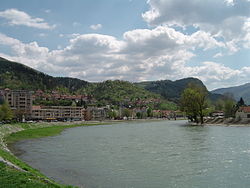Coat of arms of Prijepolje
|
Prijepolje Пријепоље |
||
|---|---|---|
| Town and municipality | ||

Lim flowing through Prijepolje
|
||
|
||
 Location of the municipality of Prijepolje within Serbia |
||
| Coordinates: 43°23′N 19°38′E / 43.383°N 19.633°ECoordinates: 43°23′N 19°38′E / 43.383°N 19.633°E | ||
| Country |
|
|
| Region | Šumadija and Western Serbia | |
| District | Zlatibor | |
| First time mentioned | 7 July 1343 | |
| Settlements | 96 | |
| Government | ||
| • Mayor | Dragoljub Zindovic | |
| Area | ||
| • Municipality | 827 km2 (319 sq mi) | |
| Elevation | 557 m (1,827 ft) | |
| Highest elevation | 1,734 m (5,689 ft) | |
| Lowest elevation | 440 m (1,440 ft) | |
| Population (2011 census) | ||
| • Town | 13,330 | |
| • Municipality | 37,059 | |
| Time zone | CET (UTC+1) | |
| • Summer (DST) | CEST (UTC+2) | |
| Postal code | 31300 | |
| Area code | +381(0)33 | |
| Car plates | PP | |
| Website | www |
|
Prijepolje (Serbian Cyrillic: Пријепоље, pronounced [prijěːpoʎe]) is a town and municipality located in the Zlatibor District of southwestern Serbia. The town of Prijepolje has 13,330 inhabitants, while the municipality has 37,059 inhabitants. It is one of the most proximate cities to the Adriatic sea in the Republic of Serbia, less than 150 miles from the sea.
One possible meaning of the name Prijepolje is "Prija's field", where Prija is the owner of polje, the "field" in English. However, a more likely theory is that the name originates from the location of Prijepolje and its relationship to the travels of caravans. When those caravans were passing through the area which would become Prijepolje, they would arrive at the settlement "before the fields", where the present day neighborhoods of Ivanje and Velika Župa are located. "Prije" means "before", and "polje" means "field", hence, the location might be called Prijepolje.
Prijepolje was established as a settlement in 1234, the same year the Mileševa Monastery was built. Prior to its establishment as a settlement, the area was occupied as far back as the stone age. First settled by Illyrians, who migrated to the area after being forced out of the northern plains, they retreated to the more defensible and less accessible mountainous regions. Later arrivals were the Celts, with whom the Illyrians intermarried. With the arrival by the Romans, the Illyrians were again forced to flee, and after the Romans, the Slavs settled in the area, intermixing with some of the earlier Illyrians. The Goths, Huns, Gepids, Langobards and Avars also passed through this area. The most interesting archaeological site in the territory is the Roman necropolis near the modern settlement of Kolovrat where pieces of ancient glass, silver, ceramics, and gold have been unearthed.
...
Wikipedia

